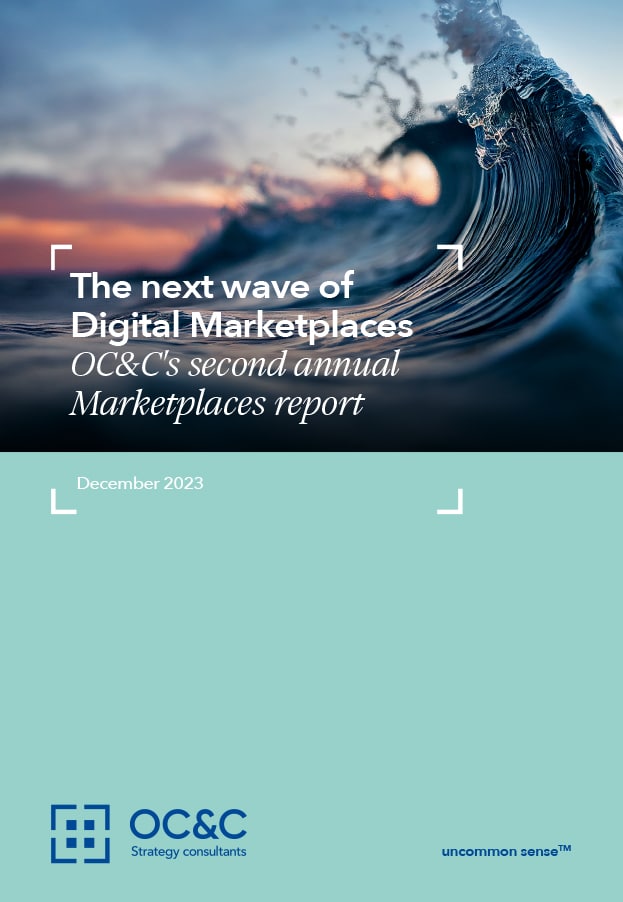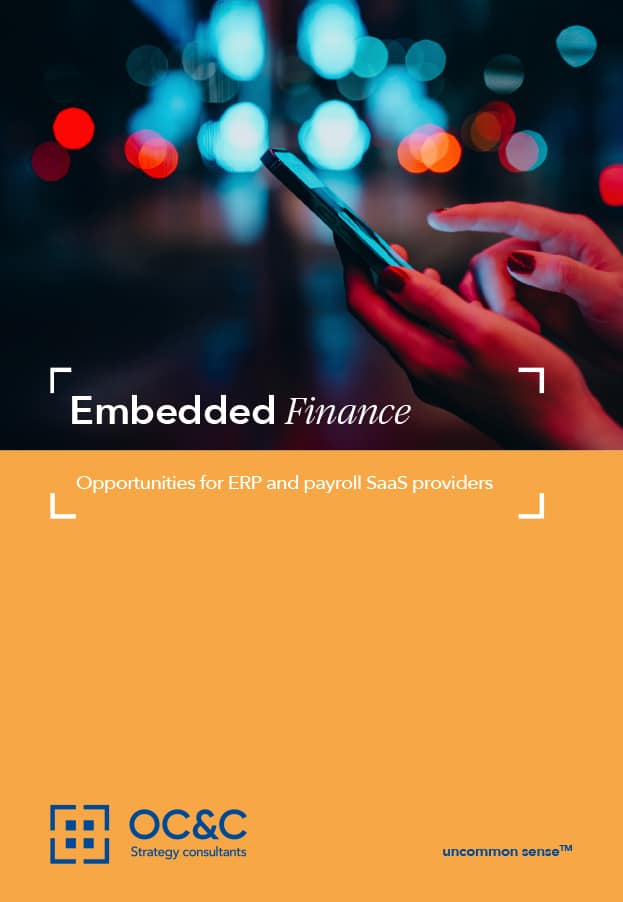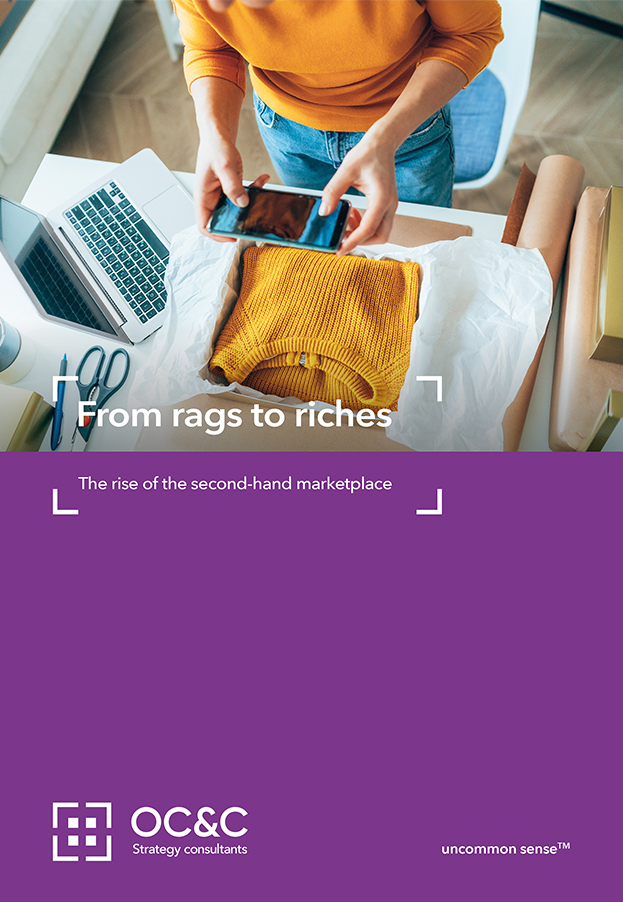The next wave of digital marketplaces
In our second marketplaces annual report, we’ve conducted a major study of the world’s top 250 digital marketplaces by gross merchandise value (GMV) to understand how they’ve been evolving in a post-pandemic area.
Key insights from our Report
- The growth of marketplaces has been astounding over the last 3 years, adding $1.7tn in consumer spending since 2019, reaching a total of $4.1tn, equivalent to the GDP of Germany.
- Specialist marketplace models – covering vertical, second-hand and local marketplaces are dominating, outgrowing generalists by a factor of nearly 2x between 2019 and 2022.
- 34 marketplaces have grown beyond $1bn in GMV in the last 3 years, primarily driven by specialist models in Europe.
- Some categories, including apparel, consumer electronics, grocery and personal care, continue to grow marketplace penetration post-Covid, presenting a significant opportunity for specialist models to continue to grow scale.
- Leading marketplaces are squeezing sellers, with the likes of Amazon, Flipkart and Mercado Libre increasing take rates by 30-50% over the last 3 years.
Online marketplaces continued to grow strongly throughout 2022, representing $4.1tn in annual gross consumer spend across first-party (1P) and third-party (3P) sales. The majority of this came from 3P sales, with the overall spend compared to other channels varying greatly per category.
In books and food delivery, for example, the marketplace model contributes to a significant proportion of the overall spend. Other categories, such as clothing, personal care and grocery categories (which have historically been less penetrated), present exciting opportunities for marketplaces to grow share in the huge $1tn+ markets.
The rise of specialist models
The defining tale of the last 3 years in Europe has been the rapid growth of specialist models, including vertical-focused, second-hand and hyperlocal marketplaces. These marketplaces provide buyers with a more curated and tailored experience and third-party sellers with new avenues for growth.
These specialist model marketplaces have been taking market share from generalists (like Amazon); growing faster by a factor of 1.6x (36%pa vs 23%pa between 2019-22) and giving rise to a new set of scale marketplaces. Since 2019, eight marketplaces have grown larger than $10bn in third-party GMV and 34 marketplaces have grown beyond $1bn.
Despite this, generalist marketplaces remain significant and still capture c.70% share of all third-party GMV in 2022. These generalists are increasingly looking to grow revenue through other means, particularly by increasing their take rate % by introducing a broader set of value-add services such as marketing fulfilment and analytics tools for sellers.
With Gen-AI also set to change the way consumers shop and impact the role of marketplaces, it is a critical time for marketplaces – whatever their size – to reconsider their long-term strategy and how to win in this evolving environment.
If you would like to talk through our findings or are looking for more information, we’d be delighted to talk.
主要联系人

Ankul Wangoo
Associate Partner

Mostyn Goodwin
Partner
In our second marketplaces annual report, we’ve conducted a major study of the world’s top 250 digital marketplaces by gross merchandise value (GMV) to understand how they’ve been evolving in a post-pandemic area.
Key insights from our Report
- The growth of marketplaces has been astounding over the last 3 years, adding $1.7tn in consumer spending since 2019, reaching a total of $4.1tn, equivalent to the GDP of Germany.
- Specialist marketplace models – covering vertical, second-hand and local marketplaces are dominating, outgrowing generalists by a factor of nearly 2x between 2019 and 2022.
- 34 marketplaces have grown beyond $1bn in GMV in the last 3 years, primarily driven by specialist models in Europe.
- Some categories, including apparel, consumer electronics, grocery and personal care, continue to grow marketplace penetration post-Covid, presenting a significant opportunity for specialist models to continue to grow scale.
- Leading marketplaces are squeezing sellers, with the likes of Amazon, Flipkart and Mercado Libre increasing take rates by 30-50% over the last 3 years.
Online marketplaces continued to grow strongly throughout 2022, representing $4.1tn in annual gross consumer spend across first-party (1P) and third-party (3P) sales. The majority of this came from 3P sales, with the overall spend compared to other channels varying greatly per category.
In books and food delivery, for example, the marketplace model contributes to a significant proportion of the overall spend. Other categories, such as clothing, personal care and grocery categories (which have historically been less penetrated), present exciting opportunities for marketplaces to grow share in the huge $1tn+ markets.
The rise of specialist models
The defining tale of the last 3 years in Europe has been the rapid growth of specialist models, including vertical-focused, second-hand and hyperlocal marketplaces. These marketplaces provide buyers with a more curated and tailored experience and third-party sellers with new avenues for growth.
These specialist model marketplaces have been taking market share from generalists (like Amazon); growing faster by a factor of 1.6x (36%pa vs 23%pa between 2019-22) and giving rise to a new set of scale marketplaces. Since 2019, eight marketplaces have grown larger than $10bn in third-party GMV and 34 marketplaces have grown beyond $1bn.
Despite this, generalist marketplaces remain significant and still capture c.70% share of all third-party GMV in 2022. These generalists are increasingly looking to grow revenue through other means, particularly by increasing their take rate % by introducing a broader set of value-add services such as marketing fulfilment and analytics tools for sellers.
With Gen-AI also set to change the way consumers shop and impact the role of marketplaces, it is a critical time for marketplaces – whatever their size – to reconsider their long-term strategy and how to win in this evolving environment.
If you would like to talk through our findings or are looking for more information, we’d be delighted to talk.
主要联系人

Ankul Wangoo
Associate Partner

Mostyn Goodwin
Partner




